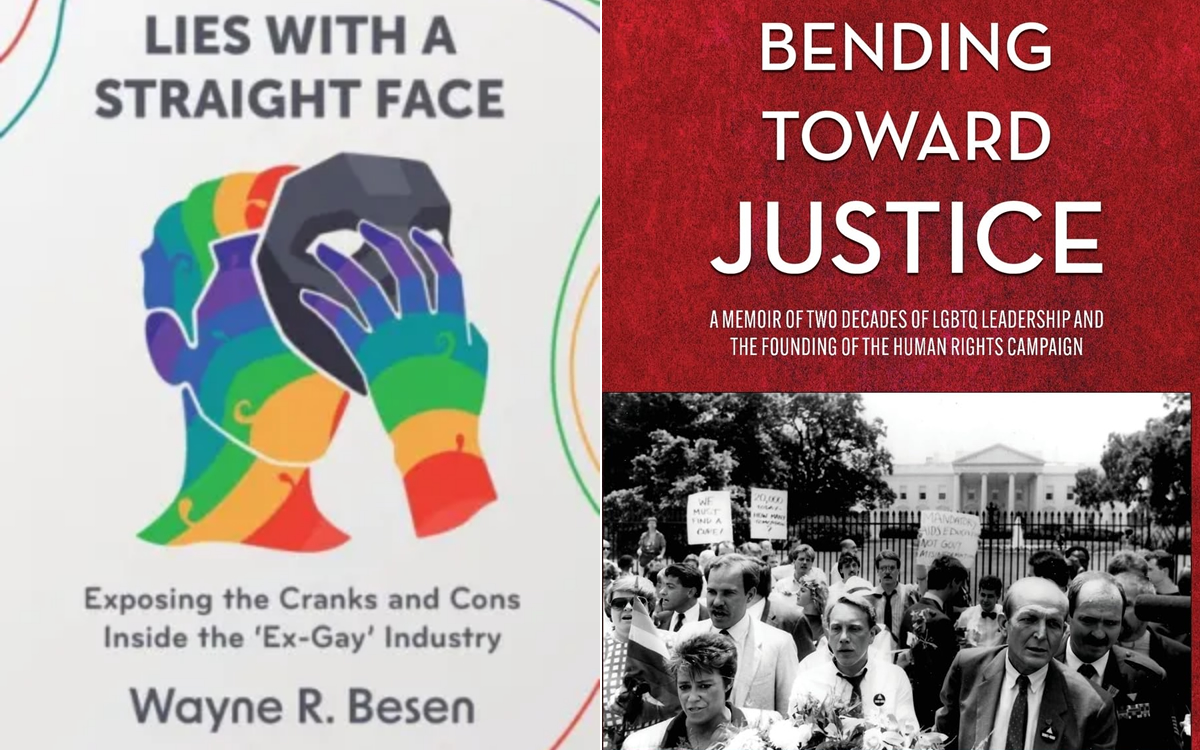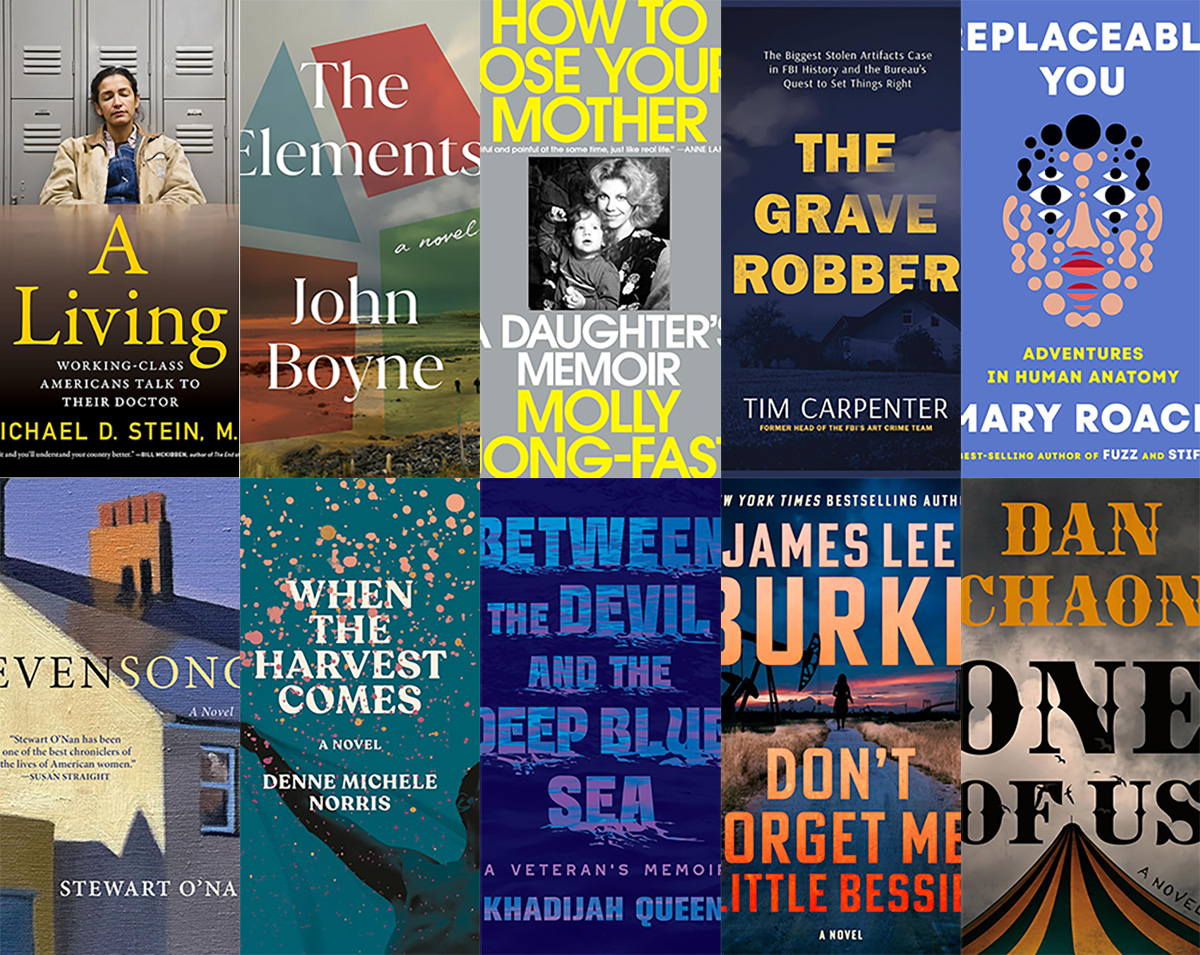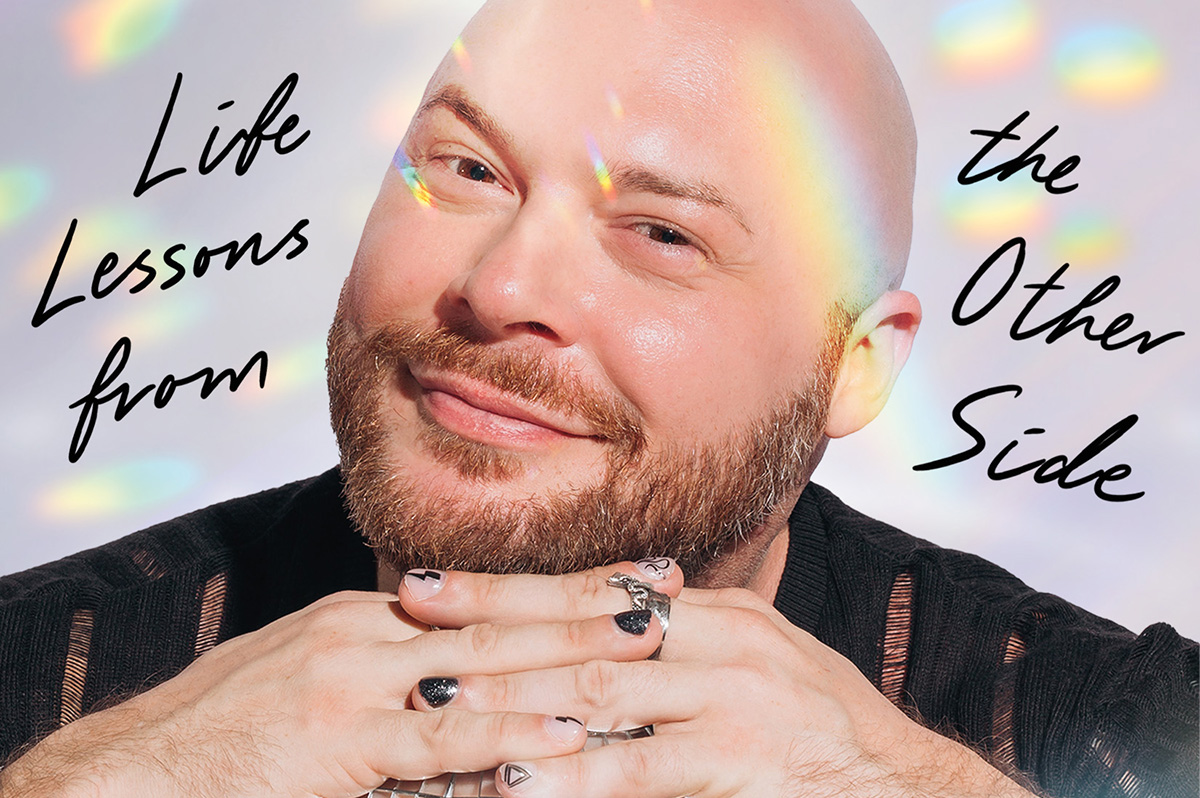Books
Two new books from longtime LGBTQ advocates not to miss
Besen on fight against conversion therapy; Basile revisits founding of HRC

This fall brings two new important books from leading LGBTQ advocates, Wayne Besen, the leading figure in the fight against so-called ‘ex-gay’ therapy; and Vic Basile, a longtime LGBTQ rights and Democratic Party activist.
“Lies with a Straight Face: Exposing the Cranks and Cons Inside the ‘Ex-Gay’ Industry,” by Besen revisits the fight against conversion therapy.
“I wrote this book to ensure that future generations know the truth about how conversion practices damage mental health, break apart families, and never work,” Besen said in a statement. All royalties from book sales will go to Truth Wins Out, to help its efforts to fight the “ex-gay” industry. Book release date is National Coming Out Day, Oct. 11. Visit waynebesen.com for more information and for a link to pre-order.
Below is an excerpt from the book:
Weird Weekend: Journey into Manhood
Twenty-four-year-old Matt Ashcroft traveled from a small town in Ontario, Canada to the woods of New Hope, Pennsylvania to attend Journey into Manhood’s (JiM) weekend retreat. It was a 48-hour “ex-gay” camp experience, that was supposed to put him on the path to heterosexuality.
Not long after he provided his John Hancock for a non-sexual experience, Matt heard the words he’ll never forget. “Don’t mind me if I have a boner,” a 50-year old man who Matt says “smelled like cat pee” intoned. The older gentleman was assigned to be Matt’s cuddle partner. The idea was to serve as a surrogate father, offering love and affection through touch that dad supposedly withheld.
When the weekend commenced, lights were dimmed in a large room, creating an atmosphere of mystery and foreboding. The campers were disoriented, with their personal items having been taken from them immediately upon arrival.
“We didn’t even have watches,” Matt explained. “We didn’t have cell phones. We had to rely on the sun to tell time. We had no sense of time. We just followed direction from the leaders that were there.”
Most of those who signed up came from stern religious communities where they had very limited access to out gay men. Far away from home, they suddenly found themselves in the forest, surrounded by similar guys with raging hormones. The pent up, closeted sexual energy, whether acted upon or not, was palpable, and lay beneath the surface.
Matt nervously peered at his malodorous cuddle partner. They were instructed to attempt the “motorcycle position”. The much older stranger would sit behind Matt and hold him, as if they were riding a Harley down the highway.
Awkwardly, the guys crouched into position. Matt squirmed and tried not to breathe, though his partner’s stale cat urine aroma gently wafted into his traumatized nostril. He could feel the mature stranger’s member inflating like a birthday balloon, poking and prodding into his backside.
What kind of “straight camp” was this? Matt thought.
Abba Dabba Doo
Arthur Abba Goldberg was out of prison and out of luck. The disbarred attorney and former Wall Street conman groped to discover the next chapter in his sordid life. He was forbidden from practicing law and banished from the financial industry, so it was unclear how he would make a living. Suddenly, like a revelation from God, it was all too obvious.
His son had come out as gay, so Goldberg would opportunistically capitalize on his family’s situation to cash in. He recruited Elaine Berk, who also had a gay son, to pose together as “experts” who could cure homosexuality. In 1999, they started Jews Offering New Alternatives to Homosexuality (JONAH), in Jersey City, as the vehicle for their scam.
To add a whiff of legitimacy, Goldberg authored, Light in the Closet: Torah, Homosexuality, and the Power to Change, which mostly cribbed NARTH’s fringe ideas and debunked theories. Additionally, Goldberg became the Executive Secretary of NARTH and President of Positive Alternatives to Homosexuality (PATH), a coalition of “ex-gay” groups promoting “non-gay alternatives to homosexual lifestyles.”
In terms of viability, there was pent up demand in the Orthodox Jewish Community for JONAH’s product. The already existing “pray away the gay” programs were geared towards Christians, offering Jesus as the answer. With an increase in the number of LGBTQ Orthodox Jews coming out every day, flummoxed family members and rabbis searched for answers on how to deal with this “abomination.” Goldberg and Berk would happily fill the vacuum, unethically profiting from other peoples’ confusion and pain.
There was one sticky problem that could potentially derail the whole scam. The name Arthur Abba Goldberg was unique. An online search would immediately reveal that he was a criminal mastermind who had done hard time for heinous crimes. The answer to his existential dilemma was simpler than one might imagine. He simply dropped the “Abba” from his name, and became one of the seemingly countless men named Arthur Goldberg, rendering himself virtually unsearchable. With a new identity and innovative swindle, Goldberg, along with Berk, put out a shingle. The legendary conman was back in business.
The ‘Ex-Gay’ Heyday
The discoveries could be startling. Dan Scobey would stumble upon relics from his fiancé Randy Thomas’ disturbing past. The man he loved deeply, and affectionally held hands with during our interview, had not too long ago been the chief lobbyist and former Vice President of Exodus International.
“You know what’s fun,” Scobey told me? “When you move in with someone and you start making your own space, and you start putting some of their things away to make room for your things. You come across framed pictures of your partner in a tuxedo, and your like, ‘that guy he’s with looks so familiar. Oh my God, that’s Karl Rove. [George W. Bush’s political guru] That, goes in the bottom of the closet!’” Scobey joked.
Today, Randy Thomas (now Scobey) embodies the titanic failure of the world’s largest “ex-gay” ministry. At its peak in 2012, Exodus International had 251 member agencies. Its lobbyists strategized with the most powerful political leaders in the land. Exodus was part of the secretive Arlington Group, which was comprised of America’s most influential social conservatives. This included former Indiana Governor and eventual Vice President Mike Pence and Donald Trump’s future political strategist Kellyanne Conway. Exodus was also a member of the DC Group, the Religious Right’s B-Team, consisting of hardcore anti-gay zealots, such as Peter LaBarbera and Robert Knight.
In 2006, the “ex-gay” industry reached its apex. Then-President George W. Bush hosted Randy Thomas and Exodus President Alan Chambers at the White House. Their role was to trumpet their “ex-gay” identity in support of Bush’s campaign to pass the odious Federal Marriage Amendment. This unsuccessful effort attempted to change the United States Constitution to ban same-sex marriage nationwide. Thomas now looks back at this epoch in his life with profound shame and regret.
“At the time, I was so proud. I was like, ‘Momma, I’m going to the White House.’ Now I look back on it, I’m like, ‘Why didn’t you yell out? Why did you betray your community like that?’ And it’s a hard thing to think about. But I’m glad that the blinders have been ripped off, and I now, of course, support full marriage equality, and I’m going to marry a dude.”
Vic Basile revisits lifetime of advocacy
Another important book debuting this fall is “Bending Toward Justice,” by Vic Basile, the Human Rights Campaign’s first executive director and co-founder of the Victory Fund.
“Bending Toward Justice” shares the history of HRC and the journey through AIDS, the attempts to get government recognition and funding for research, education, and treatment, and how HRC confronted ignorance and discrimination to shift the hearts and minds of Americans about equal treatment, according to a statement from the publisher.
“Drawing on his experience as the first executive director of the Human Rights Campaign Fund, Vic Basile has written a valuable addition to the story of one of the most consequential movements in post-World War II America,” said former gay Rep. Barney Frank (D-Mass.). The book was released this week and is available at HRC.org and Amazon. An excerpt follows:
Of Historic Significance
It was a historic moment for the fifteen hundred elegantly dressed people in Washington, D.C.’s Grand Hyatt ballroom, just blocks from the White House.
“Ladies and gentlemen,” announced Elizabeth Birch for the Human Rights Campaign, “it is now my deep honor to present to you the president of the United States.”
The crowd rose to its feet in thunderous applause. Never before had a sitting president addressed an LGBTQ audience until that moment on November 8, 1997, when President Bill Clinton was the keynote speaker at the first Human Rights Campaign National Dinner.
Ellen DeGeneres and Anne Heche were in the audience with Betty DeGeneres, Dorothy Height, Wade Henderson, Ambassador James Hormel, and elected officials, labor and corporate executives, and countless LGBTQ leaders from across the country. C-SPAN cameras ran live coverage, enabling many thousands around the country to share the historic occasion.
Although impossible to document, it seemed as though there were more reporters and cameras in the room than had ever covered an LGBTQ event before.
The historic significance of the president’s appearance that night was clear to everyone. No one could deny how far the movement had come since Stonewall. But everyone knew how much further we still had to go and how truly dangerous it could be for us just to live our lives. If those listening to the president that night had been lucky enough to avoid being gay-bashed, a quick scan of the local gay papers too often told of others who hadn’t been so fortunate. Just eleven months later, there would be no escaping the horrific description of Matthew Shepard tied to a fence and left to die in a Wyoming field.
Every person in that ballroom lived with this reality, but the older attendees knew firsthand how truly terrifying it could be to be gay during the McCarthy era’s “lavender scare.” They remembered the 1950 congressional hearings on the “Employment of Homosexuals and Other Sex Perverts” that categorized them as national security threats and described them as perverts and child molesters. They remembered when President Dwight Eisenhower issued an executive order that banned “homosexuals” from the military and civilian federal employment. They recalled the horrifying witch hunts that publicly exposed and humiliated many thousands of federal employees. Not only did many lose their careers, but many lost their families as well. Too many died by suicide.
Those older attendees likely saw the horrifying 1967 CBS documentary anchored by revered journalist Mike Wallace called “CBS Reports: The Homosexuals.”
“Most Americans are repelled by the mere notion of homosexuality,” Wallace reported. “The CBS news survey shows that two out of three Americans look upon homosexuals with disgust, discomfort, or fear. One out of ten says hatred. A vast majority believe that homosexuality is an illness; only ten percent say it is a crime. And yet, and here’s the paradox. The majority of Americans favor legal punishment, even for homosexual acts performed in private between consenting adults….
“The homosexual bitterly aware of his rejection responds by going underground. The average homosexual, if there be such is promiscuous—his sex life, his love life consists of a series of chance encounters at the clubs and bars he inhabits.”
The animus and discrimination against gay people were not confined to the federal government. Many state and local governments did the same. Florida was especially aggressive, using its notoriously cruel Johns Committee to expose and drive gay teachers, professors, and students from their jobs and academic pursuits at the state’s public universities.
During that time and well beyond it, police routinely raided gay bars, arresting patrons and releasing their names to the media. During one of these raids at the Stonewall Inn in New York’s Greenwich Village in June 1969, the patrons, some who were transgender, fought back in an uprising that would last for three days and mark the beginning of the modern-day LGBTQ rights movement.
That history, filled with richness and brutality, inspired the establishment of what is now the largest and most influential organization supporting LGBTQ rights in the country. I was the first executive director of that organization, taking it in six years from ambitious and almost viable to becoming the twenty-fourth largest of some five thousand political action committees in the United States. I led the organization’s massive lobbying effort to pass legislation mandating federal policy for fighting AIDS, we gave to more than a hundred friendly campaigns and committees, and we initiated several high-pressure actions in response to anti-gay legislation. For better or worse, politics in this country responds to money, and politicians learned they needed to respond to our community and our legislative agenda.
HRC’s growth and influence has multiplied with each succeeding leader. Today the Human Rights Campaign has some three and a half million members and supporters, some one hundred seventy-five people on staff, a building worth more than $50 million, and a budget of almost $70 million. Seven leaders have propelled the organization to its present stature.
HRC lobbies the federal, state, and municipal governments on LGBTQ legislative and regulatory matters, advocates before the courts, participates in judicial and executive branch nominations process, leads and actively works on national civil rights coalitions, educates the public, participates in elections, and works at the grassroots level on civil rights and political matters of national, state, and municipal importance.
But virtually no one remembers the handful of courageous individuals who started a small organization in 1980 to help bend that moral arc toward justice for their community. A few are still here. Many—too many—died of AIDS. All of them should be remembered, and no one more than Steve Endean, the young man who started what is now called the Human Rights Campaign with little money and a whole lot of grit.

This past year, you’ve often had to make do.
Saving money here, resources there, being inventive and innovative. It’s a talent you’ve honed, but isn’t it time to have the best? Yep, so grab these Ten Best of 2025 books for your new year pleasures.
Nonfiction
Health care is on everyone’s mind now, and “A Living: Working-Class Americans Talk to Their Doctor” by Michael D. Stein, M.D. (Melville House, $26.99) lets you peek into health care from the point of view of a doctor who treats “front-line workers” and those who experience poverty and homelessness. It’s shocking, an eye-opening book, a skinny, quick-to-read one that needs to be read now.
If you’ve been doing eldercare or caring for any loved one, then “How to Lose Your Mother: A Daughter’s Memoir” by Molly Jong-Fast (Viking, $28) needs to be in your plans for the coming year. It’s a memoir, but also a biography of Jong-Fast’s mother, Erica Jong, and the story of love, illness, and living through the chaos of serious disease with humor and grace. You’ll like this book especially if you were a fan of the author’s late mother.
Another memoir you can’t miss this year is “Between the Devil and the Deep Blue Sea: A Veteran’s Memoir” by Khadijah Queen (Legacy Lit, $30.00). It’s the story of one woman’s determination to get out of poverty and get an education, and to keep her head above water while she goes below water by joining the U.S. Navy. This is a story that will keep you glued to your seat, all the way through.
Self-improvement is something you might think about tackling in the new year, and “Replaceable You: Adventures in Human Anatomy” by Mary Roach (W.W. Norton & Company, $28.99) is a lighthearted – yet real and informative – look at the things inside and outside your body that can be replaced or changed. New nose job? Transplant, new dental work? Learn how you can become the Bionic Person in real life, and laugh while you’re doing it.
The science lover inside you will want to read “The Grave Robber: The Biggest Stolen Artifacts Case in FBI History and the Bureau’s Quest to Set Things Right” by Tim Carpenter (Harper Horizon, $29.99). A history lover will also want it, as will anyone with a craving for true crime, memoir, FBI procedural books, and travel books. It’s the story of a man who spent his life stealing objects from graves around the world, and an FBI agent’s obsession with securing the objects and returning them. It’s a fascinating read, with just a little bit of gruesome thrown in for fun.
Fiction
Speaking of a little bit of scariness, “Don’t Forget Me, Little Bessie” by James Lee Burke (Atlantic Monthly Press, $28) is the story of a girl named Bessie and her involvement with a cloven-hooved being who dogs her all her life. Set in still-wild south Texas, it’s a little bit western, part paranormal, and completely full of enjoyment.
“Evensong” by Stewart O’Nan (Atlantic Monthly Press, $28) is a layered novel of women’s friendships as they age together and support one another. The characters are warm and funny, there are a few times when your heart will sit in your throat, and you won’t be sorry you read it. It’s just plain irresistible.
If you need a dark tale for what’s left of a dark winter season, then “One of Us” by Dan Chaon (Henry Holt, $28), it it. It’s the story of twins who become orphaned when their Mama dies, ending up with a man who owns a traveling freak show, and who promises to care for them. But they can’t ever forget that a nefarious con man is looking for them; those kids can talk to one another without saying a word, and he’s going to make lots of money off them. This is a sharp, clever novel that fans of the “circus” genre shouldn’t miss.
“When the Harvest Comes” by Denne Michele Norris (Random House, $28) is a wonderful romance, a boy-meets-boy with a little spice and a lot of strife. Davis loves Everett but as their wedding day draws near, doubts begin to creep in. There’s homophobia on both sides of their families, and no small amount of racism. Beware that there’s some light explicitness in this book, but if you love a good love story, you’ll love this.
Another layered tale you’ll enjoy is “The Elements” by John Boyne (Henry Holt, $29.99), a twisty bunch of short stories that connect in a series of arcs that begin on an island near Dublin. It’s about love, death, revenge, and horror, a little like The Twilight Zone, but without the paranormal. You won’t want to put down, so be warned.
If you need more ideas, head to your local library or bookstore and ask the staff there for their favorite reads of 2025. They’ll fill your book bag and your new year with goodness.
Season’s readings!
The Blade may receive commissions from qualifying purchases made via this post.
Books
This gay author sees dead people

‘Are You There Spirit? It’s Me, Travis’
By Travis Holp
c.2025, Spiegel and Grau
$28/240 pages
Your dad sent you a penny the other day, minted in his birth year.
They say pennies from heaven are a sign of some sort, and that makes sense: You’ve been thinking about him a lot lately. Some might scoff, but the idea that a lost loved one is trying to tell you he’s OK is comforting. So read the new book, “Are You There, Spirit? It’s Me, Travis” by Travis Holp, and keep your eyes open.

Ever since he was a young boy growing up just outside Dayton, Ohio, Travis Holp wanted to be a writer. He also wanted to say that he was gay but his conservative parents believed his gayness was some sort of phase. That, and bullying made him hide who he was.
He also had to hide his nascent ability to communicate with people who had died, through an entity he calls “Spirit.” Eventually, though it left him with psychological scars and a drinking problem he’s since overcome, Holp was finally able to talk about his gayness and reveal his otherworldly ability.
Getting some people to believe that he speaks to the dead is still a tall order. Spirit helps naysayers, as well as Holp himself.
Spirit, he says, isn’t a person or an essence; Spirit is love. Spirit is a conduit of healing and energy, speaking through Holp in symbolic messages, feelings, and through synchronistic events. For example, Holp says coincidences are not coincidental; they’re ways for loved ones to convey messages of healing and energy.
To tap into your own healing Spirit, Holp says to trust yourself when you think you’ve received a healing message. Ignore your ego, but listen to your inner voice. Remember that Spirit won’t work on any fixed timeline, and its only purpose is to exist.
And keep in mind that “anything is possible because you are an unlimited being.”
You’re going to want very much to like “Are You There, Spirit? It’s Me, Travis.” The cover photo of author Travis Holp will make you smile. Alas, what you’ll find in here is hard to read, not due to content but for lack of focus.
What’s inside this book is scattered and repetitious. Love, energy, healing, faith, and fear are words that are used often – so often, in fact, that many pages feel like they’ve been recycled, or like you’ve entered a time warp that moves you backward, page-wise. Yes, there are uplifting accounts of readings that Holp has done with clients here, and they’re exciting but there are too few of them. When you find them, you’ll love them. They may make you cry. They’re exactly what you need, if you grieve. Just not enough.
This isn’t a terrible book, but its audience might be narrow. It absolutely needs more stories, less sentiment; more tales, less transcendence and if that’s your aim, go elsewhere. But if your soul cries for comfort after loss, “Are You There, Spirit? It’s Me, Travis” might still make sense.
The Blade may receive commissions from qualifying purchases made via this post.
Books
‘Dogs of Venice’ looks at love lost and rediscovered
A solo holiday trip to Italy takes unexpected turn

‘The Dogs of Venice’
By Steven Crowley
c.2025, G.P. Putnam & Sons
$20/65 pages
One person.
Two, 12, 20, you can still feel alone in a crowded room if it’s a place you don’t want to be. People say, though, that that’s no way to do the holidays; you’re supposed to Make Merry, even when your heart’s not in it. You’re supposed to feel happy, no matter what – even when, as in “The Dogs of Venice” by Steven Rowley, the Christmas tinsel seems tarnished.

Right up until the plane door closed, Paul held hope that Darren would decide to come on the vacation they’d planned for and saved for, for months.
Alas, Darren was a no-show, which was not really a surprise. Three weeks before the departure, he’d announced that their marriage wasn’t working for him anymore, and that he wanted a divorce. Paul had said he was going on the vacation anyhow. Why waste a perfectly good flight, or an already-booked B&B? He was going to Venice.
Darren just rolled his eyes.
Was that a metaphor for their entire marriage? Darren had always accused Paul of wanting too much. He indicated now that he felt stifled. Still, Darren’s unhappiness hit Paul broadside and so there was Paul, alone in a romantic Italian city, fighting with an espresso machine in a loft owned by someone who looked like a frozen-food spokeswoman.
He couldn’t speak or understand Italian very well. He didn’t know his way around, and he got lost often. But he felt anchored by a dog.
The dog – he liked to call it his dog – was a random stray, like so many others wandering around Venice unleashed, but this dog’s confidence and insouciant manner inspired Paul. If a dog could be like that, well, why couldn’t he?
He knew he wasn’t unlovable but solo holidays stunk and he hated his situation. Maybe the dog had a lesson to teach him: could you live a wonderful life without someone to watch out for, pet, and care for you?
Pick up “The Dogs of Venice,” and you might think to yourself that it won’t take long to read. At under 100 pages, you’d be right – which just gives you time to turn around and read it again. Because you’ll want to.
In the same way that you poke your tongue at a sore tooth, author Steven Rowley makes you want to remember what it’s like to be the victim of a dead romance. You can do it here safely because you simply know that Paul is too nice for it to last too long. No spoilers, though, except to say that this novel is about love – gone, resurrected, misdirected – and it unfolds in exactly the way you hope it will. All in a neat evening’s worth of reading. Perfect.
One thing to note: the Christmas setting is incidental and could just as well be any season, which means that this book is timely, no matter when you want it. So grab “The Dogs of Venice,” enjoy it twice with your book group, with your love, or read it alone.
The Blade may receive commissions from qualifying purchases made via this post.




















